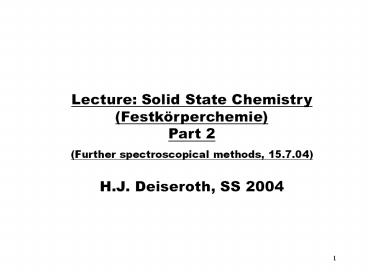Impedance spectroscopy (basic aspects) - PowerPoint PPT Presentation
Title:
Impedance spectroscopy (basic aspects)
Description:
... X-Ray Absorption Near Edge Structure - tunable synchroton radiation in the X-Ray region necessary EXAFS and XANES Thermal Analysis DTA: ... – PowerPoint PPT presentation
Number of Views:194
Avg rating:3.0/5.0
Title: Impedance spectroscopy (basic aspects)
1
Lecture Solid State Chemistry(Festkörperchemie)
Part 2 (Further spectroscopical methods,
15.7.04)H.J. Deiseroth, SS 2004
2
Orders of magnitude in size ? microscopic
techniques
3
Orders of magnitude in energy ? spectroscopic
techniques
4
Orders of magnitude in electrical conductivity
5
Impedance spectroscopy (basic aspects)
Purpose Exploring the electrical behavior of a
microcrystalline solid sample as function of an
alternating current (ac) with a variable
frequency. (note difference between ac-/dc- and
ionic/electronic conduction !!!)
three basically different regions for the
exchange interactions between current and
samplea) inside the grains (bulk)b) at
grain boundariesc) surface of the electrodes
the electrical behavior is simulated by a
suitable combination of RC circuits R
resistivity, C capacity
6
Impedance spectroscopy (electrical quantities)
The direct current (dc) resistance (R) is defined
as
U applied voltage (V), I curent (A)R
resistance (?)
The alternative quantity for an alternating
current (ac) is the impedance (Z) which,
however, is a more complex quantity than R
because there is a phase shift between U and I in
general.ac-voltage U(t) U0?sin?t (t
time, ? 2?? with ? frequency) I(t)
I0 ?sin(?t?) (? phase angle)
further details in a separate talk by Holger
Mikus this afternoon
If only capacities are present the phase shift
between voltage and current amounts to ?/2 900.
7
ESCA Photoemission or Photoelectron spectroscopy
ESCA Electron Spectroscopy for Chemical Analysis
Int.
Basic equation Eout h? - Ebind.
h?
(Eout)
Eout
strong weak
h?
Ebind.
- the higher the binding energy (Ebind.) the
lower the Eout !- ESCA is in particular a
surface sensitive method (UHV !)
Ebind.
8
ESCA Photoemission or Photoelectron Spectroscopy
Exciting Radiation Outcoming Radiation
UV ( 20 eV) ? UPS electrons from occupied valence states
X-Ray ( 10 keV) ? XPS electrons from (occupied) core states
- commercial laboratory based spectrometers
(UHV-technique) are available but relatively
expensive and of limited versatility !- more
promising for the future is the use of synchroton
radiation ? continuous spectrum of exciting
radiation (UV ? X-Ray) - intensity of
synchroton radiation is orders of magnitudes
higher ! (e.g. angle resolved detection of
outcoming radiation is possible - detection of
orbital shapes) - polarization of synchroton radiation allows spin
polarized experiments
9
Synchroton Storage Ring
10
Synchroton Radiation
Source of radiation
Magnitude of wavelength
Type of radiation
11
ESCA Photoemission or Photoelectron spectroscopy
- analysis of the energy levels of electrons in
molecules (chemical shift)- band structure of
solids
S2O32-
KCr3O8
Eout
Eout
Ebind.
Ebind.
12
ESCA Photoemission or Photoelectron spectroscopy
ESCA Electron Spectroscopy for Chemical Analysis
UPS spectrumDOS (below EF, occupied states
only)Band structure (chemical bonding in
different directions of a crystalline solid)
The energy spectrum of the emitted electrons is
analyzed ! - energy - momentum - spin
energy
13
Moessbauer Spectroscopy
? the nucleus of the specific isotope of an atom
embdedded in a solid (e.g. 57Fe) is excited by
?-rays emitted by an instable isotope of a
neighbor element (e.g. 57Co)
Chemical shift and Hyperfine splitting
source e.g. 57Co(tunable)
absorber e.g. 57Fe
frequently applied for? 57Fe, 119Sn, 127J ...?
chemical surrounding (symmetry, coordination
number, oxidation state, magnetism) of atoms with
these nuclei in a solid can be probed in a highly
sensitive way (10-8 eV)
Doppler effect
14
Moessbauer Spectroscopy
Two major informations from Moessbauer
spectra a) Chemical Shift(not to be
confused with the same term in NMR and ESCA)?
oxidation state b) Hyperfine Splitting ?
magnetic interactions
15
EXAFS and XANES
Spectroscopical methods associated with specific
physical effects at/near characteristical X-ray
absorption edgesEXAFS Extended X-Ray
Absorption Fine StructureXANES X-Ray Absorption
Near Edge Structure - tunable synchroton
radiation in the X-Ray region necessary
16
Thermal Analysis DTA Differential Thermal
Analysis
17
TG Thermogravimetry(mass change during heating
or cooling combined with DTA)
Hysteresis ?
18
Thermal Analysis
DSC Differential Scanning Calorimetry-
Quantitative measurement of enthalpy
changesTMA Thermo Mechanical Analysis
(dilatometry)- Mechanical changes that occur
upon temperature changes(see lab courses in
inorganic chemistry and construction materials
chemistry)































